|
Notes: The construction of a railway north from Birmingham Snow Hill to Priestfield, where it would meet the Oxford, Worcester & Wolverhampton Railway (OWWR) was authorised on 3 August 1846 to the Birmingham, Wolverhampton & Dudley Railway (BWDR). The BWDR favoured leasing the line to the Great Western Railway (GWR) from the outset as it planned the line to be constructed to the GWR’s broad gauge (7ft 0¼in) rather than what was, increasingly, the standard gauge (4ft 8½in). Negotiations with the GWR with regard to leasing and running the line started on 12 November 1846, only months after the railway company had been incorporated, and by Act of Parliament of 31 August 1848 the BWDR was purchased by the GWR prior to any construction taking place. Construction of the line was started by the GWR during 1851 and by June 1852 the original Act was due to lapse and the GWR successfully applied to Parliament for a 3½-year extension to the original Act. The GWR had attempted not to construct the line at all preferring to negotiate with the London & North Western Railway (LNWR) to gain running rights along the Stour Valley line; negotiations failed as the, ever suspicious, LNWR was attempting to delay the GWR reaching its ultimate goal, Liverpool.
Construction of the OWWR line was authorised by Act of Parliament on 7 August 1845 as an 89-mile mixed gauge railway (7ft and 4ft 8½in) from Oxford to Wolverhampton via Worcester. The GWR subscribed to the building in their efforts to reach further north and into the area dominated by the LNWR. The chief engineer of the project, Isambard Kingdom Brunel, estimated the cost of construction to be £1.5 million, a hefty sum in the 1840s. By the late 1840s construction was painfully slow and costs were starting to overtake the original estimate, and the OWWR were forced to re-evaluate the total cost of the project. It was found that the final cost would be nearer £2.5 million to complete the line and, following a skirmish with an unpaid contractor and some 2,000 of his men at Mickleton, Gloucestershire in which Brunel amassed an ‘army’ of 2,000 navvies for the stand-off, the GWR started to grow ‘cold’ on the project. By 1850 construction had ground to a halt and years of legal action by the OWWR against the GWR had failed to complete the line. A London solicitor, John Parson, became a majority shareholder in the OWWR in 1850 and would be the instrumental driving force to complete the project. Having drawn a blank with the GWR for over 12 months he approached the LNWR and the MR to complete the line; it was a step too far for the GWR. No sooner had the LNWR and MR signed the agreement of 21 February 1851 to complete the construction, when the GWR had the agreement declared void in the Court of Chancery and subsequently offered the OWWR a similar agreement. The Stourbridge to Dudley section was finally completed and opened on 16 November 1852 to goods, and 20 December 1852 to passengers. The line did not reach Wolverhampton until April 1854 for goods and 1 July for passengers. This was mainly due to legal wrangling between the OWWR and the GWR over the issue of mixed gauge track running all the way to Wolverhampton and the doubts over the safety of several bridges along the route.
Construction of the Snow Hill to Priestfield section of the BWDR was complete by the summer of 1854 and the line was duly inspected by Captain Sir Douglas Strutt-Galton in August. It is not recorded whether or not the inspection was a success but the following day a tubular bridge over the turnpike road at Winson Green collapsed following the passage of a contractor’s locomotive working a ballast train. Isambard Kingdom Brunel visited the line the following day and a thorough inspection of the bridges along the route with John Mc Clean, the resident engineer, resulted in five of them being condemned. The opening of the line had been set for 1 September 1854 but this was now unachievable as remedial work on the structures was to take some months. Following the strengthening of the five bridges the line was again inspected and passed fit for traffic, opening on 14 November 1854.

The station was constructed directly south of Priestfield Junction thus having two platforms which served the former OWWR and two which served the BWDR. It opened in two stages with the OWWR platforms opening on 5 July 1854 and the BWDR platforms on 2 July 1855 both dates being after the opening of the respective lines for which the platforms served. The layout of the station was determined by its location, the Wolverhampton-bound platform of the BW&DR (down) and the Dudley-bound platform of the OWWR (up) were sited in the ‘V’ of Priestfield Junction. Access to the station was provided through an unassuming gateway from Sidwick Crescent via a ramp directly to the Wolverhampton(GWR)/Dudley(OWWR) platform a further entrance was via a ramp from John Street to the Wolverhampton (OWWR) platfom. A small waiting room was provided on this platform which resembled, not only in build but size, a garden shed. A footbridge, which spanned all lines, gave access to two.jpg) further, single-face platforms. The Wolverhampton-bound (down) platform of the OWWR lay to the left upon which was a slightly larger wooden building which looks to have used for staff accommodation as well as a booking office. The Birmingham-bound platform (up) of the BWDR line was located to the right, having ascended the stairs, from the entrance platform. A small waiting shelter was provided close to the foot of the stairs, with a footpath running to its rear leading to a larger building which was located within the railway boundary and was probably the original booking office. Map evidence clearly shows the building standing from the late 1880s through to the 1930s although on post-war maps the building has disappeared along with the connecting footpath; no photographic evidence has been un-earthed. A few gas lanterns were provided on each platform along with the footbridge and entrance. Due to its proximity to Wolverhampton no goods services seem to have been provided at the station with the local area probably well served by the numerous facilities close by. further, single-face platforms. The Wolverhampton-bound (down) platform of the OWWR lay to the left upon which was a slightly larger wooden building which looks to have used for staff accommodation as well as a booking office. The Birmingham-bound platform (up) of the BWDR line was located to the right, having ascended the stairs, from the entrance platform. A small waiting shelter was provided close to the foot of the stairs, with a footpath running to its rear leading to a larger building which was located within the railway boundary and was probably the original booking office. Map evidence clearly shows the building standing from the late 1880s through to the 1930s although on post-war maps the building has disappeared along with the connecting footpath; no photographic evidence has been un-earthed. A few gas lanterns were provided on each platform along with the footbridge and entrance. Due to its proximity to Wolverhampton no goods services seem to have been provided at the station with the local area probably well served by the numerous facilities close by.
The mixed gauge line was converted to standard gauge during 1869.
Bradshaw of December 1895 shows the station well served with trains running, weekdays, in the Wolverhampton (down) direction from 6.33am until 11.26pm and 7.28am until 11.20pm in the .jpg) Birmingham & Dudley (up) direction, a total of 25 down and 22 up services. The service was reduced on Sunday, as was common practice, to nine down trains, the first at 7.51am and last at 9.55pm, and thirteen up trains ranging from 8.20am until 9.45pm. The First World War saw the curtailment of many services as was seen throughout the rest of the country. By July 1922 Bradshaw indicates that the weekday service had increased to 30 down services and 33 up services with the Sunday service showing eight down trains and nine up trains. Birmingham & Dudley (up) direction, a total of 25 down and 22 up services. The service was reduced on Sunday, as was common practice, to nine down trains, the first at 7.51am and last at 9.55pm, and thirteen up trains ranging from 8.20am until 9.45pm. The First World War saw the curtailment of many services as was seen throughout the rest of the country. By July 1922 Bradshaw indicates that the weekday service had increased to 30 down services and 33 up services with the Sunday service showing eight down trains and nine up trains.
Bradshaw's December 1895 showing a selection of services along the former OWWR line
Click here to see a larger version
At the time of the ‘Big Four’ Grouping of 1 January 1923 Priestfield remained under the control of the GWR.
From map evidence changes to the station’s layout and infrastructure were minimal from its opening in 1854 through to the 1930s. The only significant change was the demolition, sometime in the 1930s, of the building situated off the Birmingham platform. Platform tiles of the GWR pattern were also laid and additional platform lighting was provided in the 1950s.
On 1 January 1948 the railways were nationalised and Priestfield came under the control of British Railways (BR) Western Region (WR). During the London Midland Region’s (LMR) electrification programme of the West Coast Main Line (WCML), started in 1958, the line saw an increase in passenger services as many extra trains were run via the WR metals to compensate for the reduction in services on the WCML. Although this did not affect the service at Priestfield it seemed to cement the former GWR route as still being a primary main line. Plans revealed by the BR(WR) in the early 1960s for the rebuilding of Snow Hill and the introduction of new diesel Pullman services all pointed towards the future being bright. On 1 January 1963 boundaries of BR regions were redrawn and Priestfield station came under the control of BR(LMR) and with the completion of the electrification programme and the linking of the main line from Paddington to Birmingham New Street the route north of Snow Hill was considered to be secondary.
Service levels changed relatively little during the period from the station’s opening until the early 1950s with the May 1949 British Railways timetable showing 32 down (Wolverhampton direction) and 35 up departures on Monday-to-Friday, with a slight reduction on Saturday. Sunday was still busy with 11 down services and 15 up. The mid 1950s saw the number of longer distance services calling at the station reduce in favour of just local services. In 1949 it was still possible to travel to Birkenhead Woodside or London Paddington from Priestfield on a variety of trains, seven days a week. Late in the 1950s WR totem name signs were installed.
In the early 1960s the WR implemented the withdrawal of passenger services over the Kidderminster to Wolverhampton section, and on 30 July 1962 the passenger service ran for the final time ushering in a turbulent decade for Priestfield station. The service did gain a mention in The Reshaping of British Railways, published in 1963, marked with an asterisk to denote closure was .jpg) already implemented. The line through to Dudley remained open for freight until 1968 when it was lifted, leaving the station with just two platform faces in use. Things started to go from bad to worse when in 1966 BR LMR issued a proposal to close the Birmingham Snow Hill to Wolverhampton Low Level route, and all stations, in its entirety. In 1966 there were 24 trains in each direction to and from Wolverhampton, with around 2,000 people per day travelling on these services – the figure includes the Snow Hill to Langley Green shuttle. Objections were posted to the Transport Users’ Consultative Committee (TUCC) and the case for closure was discussed on 20 September 1966. The recommendation of the TUCC was the line was to remain open as closure would cause ‘extreme hardship’. This ruling caused the LMR to change tactics with the announcement that as of 4 March 1967 the main line trains, along the whole route would be withdrawn and freight trains diverted along other routes. On 15 November 1967 the Minister of Transport, Barbara Castle, responded to BR’s closure application refusing to allow the closure of the Wolverhampton to Snow Hill and the branch to Langley Green but allowing the closure of the southern section from Snow Hill towards Stratford and Leamington. The LMR reduced the service level dramatically; with the introduction of the May 1968 timetable Priestfield saw just 14 down (Wolverhampton direction) services on Monday-to-Friday and 16 on Saturday, whilst the up workings consisted of 16 workings on Monday-to-Saturday and the Sunday service was withdrawn. The May 1969 timetable saw the service reduced even further as the LMR attempted to undermine the line’s viability by running as few trains as possible; the station at Priestfield lost its complement of staff at the same time. Vandalism became a real problem as soon already implemented. The line through to Dudley remained open for freight until 1968 when it was lifted, leaving the station with just two platform faces in use. Things started to go from bad to worse when in 1966 BR LMR issued a proposal to close the Birmingham Snow Hill to Wolverhampton Low Level route, and all stations, in its entirety. In 1966 there were 24 trains in each direction to and from Wolverhampton, with around 2,000 people per day travelling on these services – the figure includes the Snow Hill to Langley Green shuttle. Objections were posted to the Transport Users’ Consultative Committee (TUCC) and the case for closure was discussed on 20 September 1966. The recommendation of the TUCC was the line was to remain open as closure would cause ‘extreme hardship’. This ruling caused the LMR to change tactics with the announcement that as of 4 March 1967 the main line trains, along the whole route would be withdrawn and freight trains diverted along other routes. On 15 November 1967 the Minister of Transport, Barbara Castle, responded to BR’s closure application refusing to allow the closure of the Wolverhampton to Snow Hill and the branch to Langley Green but allowing the closure of the southern section from Snow Hill towards Stratford and Leamington. The LMR reduced the service level dramatically; with the introduction of the May 1968 timetable Priestfield saw just 14 down (Wolverhampton direction) services on Monday-to-Friday and 16 on Saturday, whilst the up workings consisted of 16 workings on Monday-to-Saturday and the Sunday service was withdrawn. The May 1969 timetable saw the service reduced even further as the LMR attempted to undermine the line’s viability by running as few trains as possible; the station at Priestfield lost its complement of staff at the same time. Vandalism became a real problem as soon .jpg) as the station became unstaffed and the platform buildings were demolished by October 1970. Platform lighting would also suffer from vandalism and was not to be repaired so the station ended up without lights and shelter, hardly attractive to the would-be traveller. Between May 1969 and March 1972 the service remained at a constant level of six services each way on Monday-to-Friday with one extra working on Saturday, in the early afternoon, to cater for shoppers wishing to travel to Birmingham or Wolverhampton. Passenger numbers had dwindled to one tenth of what they had been in 1966 and on 31 March 1971 the LMR made its move and posted closure notices for Wolverhampton Low Level to Birmingham Snow Hill, including the Langley Green shuttle. Objections had to be received by 19 May 1971. The Transport Users’ Consultative Committee received 199 objections in total and on 25 May they, along with representatives from BR and WMPTE (the Executive body of the WMPTA), inspected the route and all the stations, travelling from Snow Hill by train to Wolverhampton; ironically, they returned by bus! A Public Hearing was held at the Rainbow Suite in Birmingham on 14 July 1971 to hear objections and decide the future of the line. The statement issued by the TUCC could not have been clearer: ‘The addition of displaced rail passengers at these times would aggravate an already critical situation and would result in hardship for all concerned’. Nevertheless, on 24 January 1972 the Minister granted permission for closure to be implemented, with a date quickly set for 4 March. On the final day trains were expected to be heavily patronised, so instead of being the usual single car DMU the trains were strengthened to three car units with BR issuing souvenir tickets. The final Wolverhampton-bound train called at Priestfield at 6.16pm with the final Birmingham bound service having departed 5.51pm. as the station became unstaffed and the platform buildings were demolished by October 1970. Platform lighting would also suffer from vandalism and was not to be repaired so the station ended up without lights and shelter, hardly attractive to the would-be traveller. Between May 1969 and March 1972 the service remained at a constant level of six services each way on Monday-to-Friday with one extra working on Saturday, in the early afternoon, to cater for shoppers wishing to travel to Birmingham or Wolverhampton. Passenger numbers had dwindled to one tenth of what they had been in 1966 and on 31 March 1971 the LMR made its move and posted closure notices for Wolverhampton Low Level to Birmingham Snow Hill, including the Langley Green shuttle. Objections had to be received by 19 May 1971. The Transport Users’ Consultative Committee received 199 objections in total and on 25 May they, along with representatives from BR and WMPTE (the Executive body of the WMPTA), inspected the route and all the stations, travelling from Snow Hill by train to Wolverhampton; ironically, they returned by bus! A Public Hearing was held at the Rainbow Suite in Birmingham on 14 July 1971 to hear objections and decide the future of the line. The statement issued by the TUCC could not have been clearer: ‘The addition of displaced rail passengers at these times would aggravate an already critical situation and would result in hardship for all concerned’. Nevertheless, on 24 January 1972 the Minister granted permission for closure to be implemented, with a date quickly set for 4 March. On the final day trains were expected to be heavily patronised, so instead of being the usual single car DMU the trains were strengthened to three car units with BR issuing souvenir tickets. The final Wolverhampton-bound train called at Priestfield at 6.16pm with the final Birmingham bound service having departed 5.51pm.
 The 1972 BR Timetable was published with the service still showing as operating although with a bordered notice stating the service was under consideration for withdrawal. The 1972 BR Timetable was published with the service still showing as operating although with a bordered notice stating the service was under consideration for withdrawal.
Shortly after withdrawal of the passenger service the footbridge was removed from the station site although the line continued to be used for delivery of steel to the Wolverhampton Steel Terminal at Monmore Green. Trains ran from the yard at Bescot via the South Staffordshire line accessing the former GWR main line at Princes End Junction. These services continued to run until 7 May 1983 when trains were routed via the Soho Loop and the Stour Valley line. The line was subsequently lifted north of the junction for Bilston New Basin and through Priestfield.
The West Midlands Public Transport Authority (WMPTA) had long recognised the importance of the Wolverhampton to Birmingham Snow Hill route although it became responsible for rail services only in 1972, so nothing could be done to stop the initial closure. On 31 October 1973 the Authority and its Executive body took steps to protect the trackbed from any future development so that some kind of public transport system could be reintroduced. The Authoritiy’s first success was the rebuilding of Snow Hill, in the late 1980s, and the introduction of heavy rail services north of the station to Stourbridge and Kidderminster in 1995. With the first Metro proposal having to be abandoned owing to public opposition and construction difficulties, the route of the former relief lines from Snow Hill to Swan Village and onward using the trackbed of the former double track main line to Wolverhampton was chosen. The WMPTA announced this on 16 February 1988 and on 16 November 1989 an Act of Parliament was granted for its construction. It was not until 3 August 1995 that the contract for construction was let to Altram, a consortium of Ansaldo and John Laing, with construction commencing on 13 November. The final section of track was laid on 4 February 1998 with public services beginning on 31 May 1999. A new tram stop bearing the name Priestfield is located just to the north of the original station site.
Today there is no trace of a station ever having existed here. The OWWR platforms were completely infilled in the late 1990s with a small open space now occupying their site. The trackbed of the main route to Birmingham was safeguarded and now sees a regular tram service between Wolverhampton and Birmingham.
Tickets from Michael Stewart, route map by Alan Young and Totem from Richard Furness
Sources:
- Bradshaw's Railway Guide December 1895 - Middleton Press
- Forgotten Railways: Volume 10, The West Midlands - Rex Christinsen - David & Charles Publishing 1985
- A Regional History of the Railways of Great Britain - Volume 7 The West Midlands - Rex Christiansen - David St John Thomas Publisher 1991
- A Century of Railways around Birmingham and the West Midlands Vol 1,2 & 3 - John Boynton - Mid England Books Publisher 1999
- From Main Line To Metro - John Boynton - Mid England Books 2001
- Railway Passenger Station in Great Britain - A Chronology - Michael Quick - Railway & Canal Historical Society 2009
|

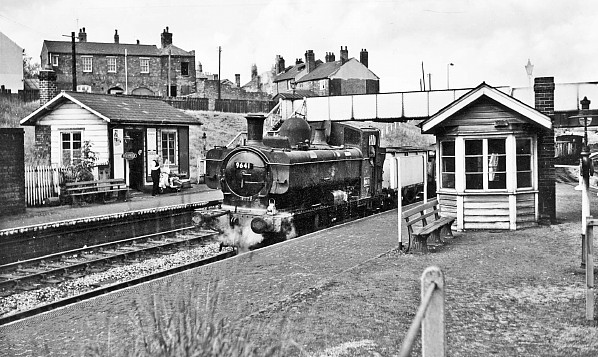
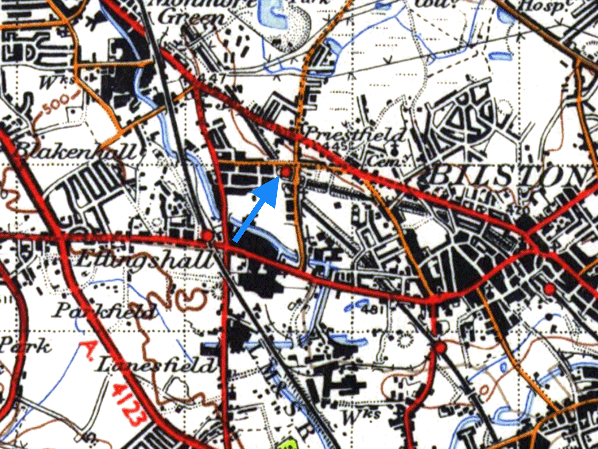

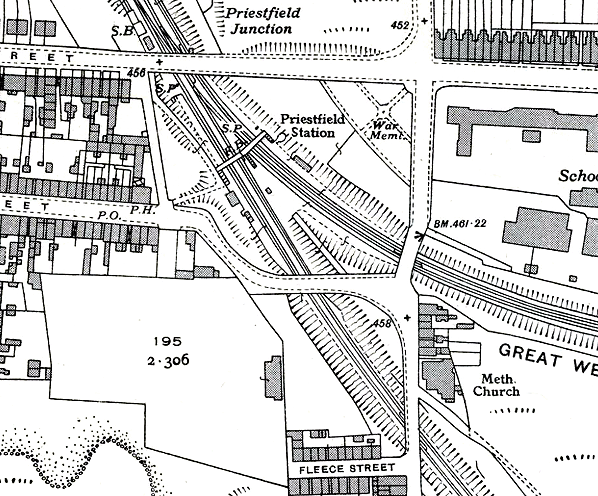 Priestfield station shown on a 25-inch map from 1938.
Priestfield station shown on a 25-inch map from 1938.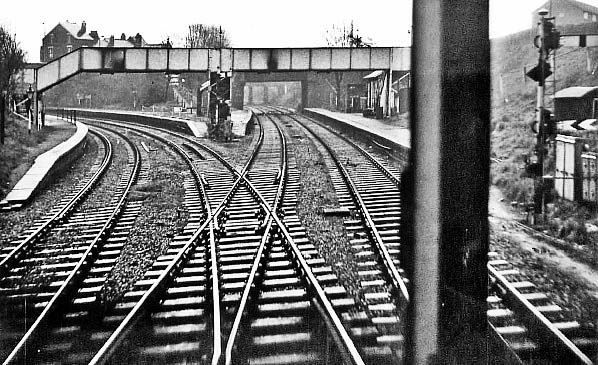


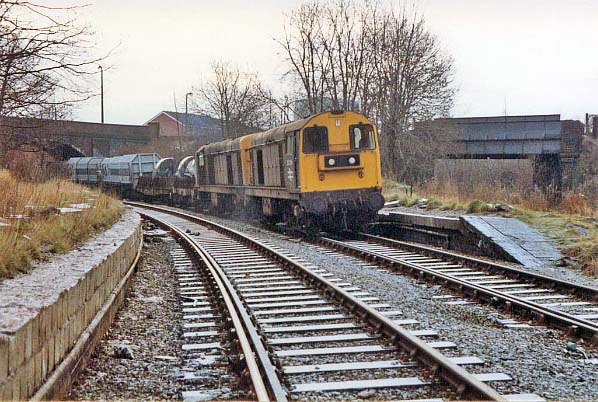
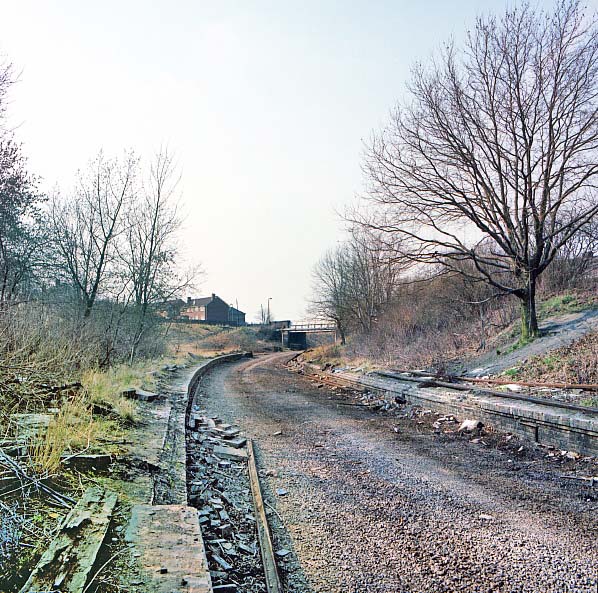
 Home Page
Home Page totem.gif)

.jpg) further, single-face platforms. The Wolverhampton-bound (down) platform of the OWWR lay to the left upon which was a slightly larger wooden building which looks to have used for staff accommodation as well as a booking office. The Birmingham-bound platform (up) of the BWDR line was located to the right, having ascended the stairs, from the entrance platform. A small waiting shelter was provided close to the foot of the stairs, with a footpath running to its rear leading to a larger building which was located within the railway boundary and was probably the original booking office. Map evidence clearly shows the building standing from the late 1880s through to the 1930s although on post-war maps the building has disappeared along with the connecting footpath; no photographic evidence has been un-earthed. A few gas lanterns were provided on each platform along with the footbridge and entrance. Due to its proximity to Wolverhampton no goods services seem to have been provided at the station with the local area probably well served by the numerous facilities close by.
further, single-face platforms. The Wolverhampton-bound (down) platform of the OWWR lay to the left upon which was a slightly larger wooden building which looks to have used for staff accommodation as well as a booking office. The Birmingham-bound platform (up) of the BWDR line was located to the right, having ascended the stairs, from the entrance platform. A small waiting shelter was provided close to the foot of the stairs, with a footpath running to its rear leading to a larger building which was located within the railway boundary and was probably the original booking office. Map evidence clearly shows the building standing from the late 1880s through to the 1930s although on post-war maps the building has disappeared along with the connecting footpath; no photographic evidence has been un-earthed. A few gas lanterns were provided on each platform along with the footbridge and entrance. Due to its proximity to Wolverhampton no goods services seem to have been provided at the station with the local area probably well served by the numerous facilities close by..jpg) Birmingham & Dudley (up) direction, a total of 25 down and 22 up services. The service was reduced on Sunday, as was common practice, to nine down trains, the first at 7.51am and last at 9.55pm, and thirteen up trains ranging from 8.20am until 9.45pm. The First World War saw the curtailment of many services as was seen throughout the rest of the country. By July 1922 Bradshaw indicates that the weekday service had increased to 30 down services and 33 up services with the Sunday service showing eight down trains and nine up trains.
Birmingham & Dudley (up) direction, a total of 25 down and 22 up services. The service was reduced on Sunday, as was common practice, to nine down trains, the first at 7.51am and last at 9.55pm, and thirteen up trains ranging from 8.20am until 9.45pm. The First World War saw the curtailment of many services as was seen throughout the rest of the country. By July 1922 Bradshaw indicates that the weekday service had increased to 30 down services and 33 up services with the Sunday service showing eight down trains and nine up trains.
.jpg) already implemented. The line through to Dudley remained open for freight until 1968 when it was lifted, leaving the station with just two platform faces in use. Things started to go from bad to worse when in 1966 BR LMR issued a proposal to close the Birmingham Snow Hill to Wolverhampton Low Level route, and all stations, in its entirety. In 1966 there were 24 trains in each direction to and from Wolverhampton, with around 2,000 people per day travelling on these services – the figure includes the Snow Hill to Langley Green shuttle. Objections were posted to the Transport Users’ Consultative Committee (TUCC) and the case for closure was discussed on 20 September 1966. The recommendation of the TUCC was the line was to remain open as closure would cause ‘extreme hardship’. This ruling caused the LMR to change tactics with the announcement that as of 4 March 1967 the main line trains, along the whole route would be withdrawn and freight trains diverted along other routes. On 15 November 1967 the Minister of Transport, Barbara Castle, responded to BR’s closure application refusing to allow the closure of the Wolverhampton to Snow Hill and the branch to Langley Green but allowing the closure of the southern section from Snow Hill towards Stratford and Leamington. The LMR reduced the service level dramatically; with the introduction of the May 1968 timetable Priestfield saw just 14 down (Wolverhampton direction) services on Monday-to-Friday and 16 on Saturday, whilst the up workings consisted of 16 workings on Monday-to-Saturday and the Sunday service was withdrawn. The May 1969 timetable saw the service reduced even further as the LMR attempted to undermine the line’s viability by running as few trains as possible; the station at Priestfield lost its complement of staff at the same time. Vandalism became a real problem as soon
already implemented. The line through to Dudley remained open for freight until 1968 when it was lifted, leaving the station with just two platform faces in use. Things started to go from bad to worse when in 1966 BR LMR issued a proposal to close the Birmingham Snow Hill to Wolverhampton Low Level route, and all stations, in its entirety. In 1966 there were 24 trains in each direction to and from Wolverhampton, with around 2,000 people per day travelling on these services – the figure includes the Snow Hill to Langley Green shuttle. Objections were posted to the Transport Users’ Consultative Committee (TUCC) and the case for closure was discussed on 20 September 1966. The recommendation of the TUCC was the line was to remain open as closure would cause ‘extreme hardship’. This ruling caused the LMR to change tactics with the announcement that as of 4 March 1967 the main line trains, along the whole route would be withdrawn and freight trains diverted along other routes. On 15 November 1967 the Minister of Transport, Barbara Castle, responded to BR’s closure application refusing to allow the closure of the Wolverhampton to Snow Hill and the branch to Langley Green but allowing the closure of the southern section from Snow Hill towards Stratford and Leamington. The LMR reduced the service level dramatically; with the introduction of the May 1968 timetable Priestfield saw just 14 down (Wolverhampton direction) services on Monday-to-Friday and 16 on Saturday, whilst the up workings consisted of 16 workings on Monday-to-Saturday and the Sunday service was withdrawn. The May 1969 timetable saw the service reduced even further as the LMR attempted to undermine the line’s viability by running as few trains as possible; the station at Priestfield lost its complement of staff at the same time. Vandalism became a real problem as soon .jpg) as the station became unstaffed and the platform buildings were demolished by October 1970. Platform lighting would also suffer from vandalism and was not to be repaired so the station ended up without lights and shelter, hardly attractive to the would-be traveller. Between May 1969 and March 1972 the service remained at a constant level of six services each way on Monday-to-Friday with one extra working on Saturday, in the early afternoon, to cater for shoppers wishing to travel to Birmingham or Wolverhampton. Passenger numbers had dwindled to one tenth of what they had been in 1966 and on 31 March 1971 the LMR made its move and posted closure notices for Wolverhampton Low Level to Birmingham Snow Hill, including the Langley Green shuttle. Objections had to be received by 19 May 1971. The Transport Users’ Consultative Committee received 199 objections in total and on 25 May they, along with representatives from BR and WMPTE (the Executive body of the WMPTA), inspected the route and all the stations, travelling from Snow Hill by train to Wolverhampton; ironically, they returned by bus! A Public Hearing was held at the Rainbow Suite in Birmingham on 14 July 1971 to hear objections and decide the future of the line. The statement issued by the TUCC could not have been clearer: ‘The addition of displaced rail passengers at these times would aggravate an already critical situation and would result in hardship for all concerned’. Nevertheless, on 24 January 1972 the Minister granted permission for closure to be implemented, with a date quickly set for 4 March. On the final day trains were expected to be heavily patronised, so instead of being the usual single car DMU the trains were strengthened to three car units with BR issuing souvenir tickets. The final Wolverhampton-bound train called at Priestfield at 6.16pm with the final Birmingham bound service having departed 5.51pm.
as the station became unstaffed and the platform buildings were demolished by October 1970. Platform lighting would also suffer from vandalism and was not to be repaired so the station ended up without lights and shelter, hardly attractive to the would-be traveller. Between May 1969 and March 1972 the service remained at a constant level of six services each way on Monday-to-Friday with one extra working on Saturday, in the early afternoon, to cater for shoppers wishing to travel to Birmingham or Wolverhampton. Passenger numbers had dwindled to one tenth of what they had been in 1966 and on 31 March 1971 the LMR made its move and posted closure notices for Wolverhampton Low Level to Birmingham Snow Hill, including the Langley Green shuttle. Objections had to be received by 19 May 1971. The Transport Users’ Consultative Committee received 199 objections in total and on 25 May they, along with representatives from BR and WMPTE (the Executive body of the WMPTA), inspected the route and all the stations, travelling from Snow Hill by train to Wolverhampton; ironically, they returned by bus! A Public Hearing was held at the Rainbow Suite in Birmingham on 14 July 1971 to hear objections and decide the future of the line. The statement issued by the TUCC could not have been clearer: ‘The addition of displaced rail passengers at these times would aggravate an already critical situation and would result in hardship for all concerned’. Nevertheless, on 24 January 1972 the Minister granted permission for closure to be implemented, with a date quickly set for 4 March. On the final day trains were expected to be heavily patronised, so instead of being the usual single car DMU the trains were strengthened to three car units with BR issuing souvenir tickets. The final Wolverhampton-bound train called at Priestfield at 6.16pm with the final Birmingham bound service having departed 5.51pm.
 The 1972 BR Timetable was published with the service still showing as operating although with a bordered notice stating the service was under consideration for withdrawal.
The 1972 BR Timetable was published with the service still showing as operating although with a bordered notice stating the service was under consideration for withdrawal.
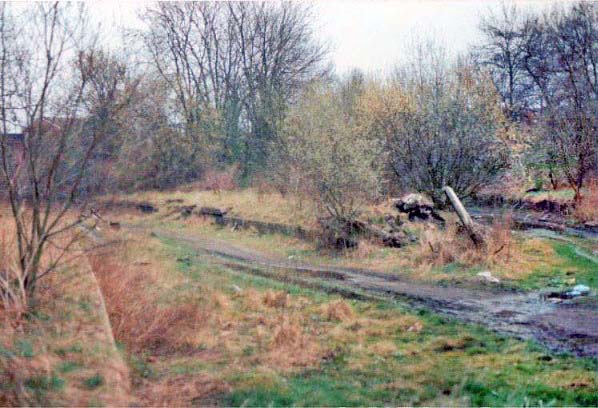
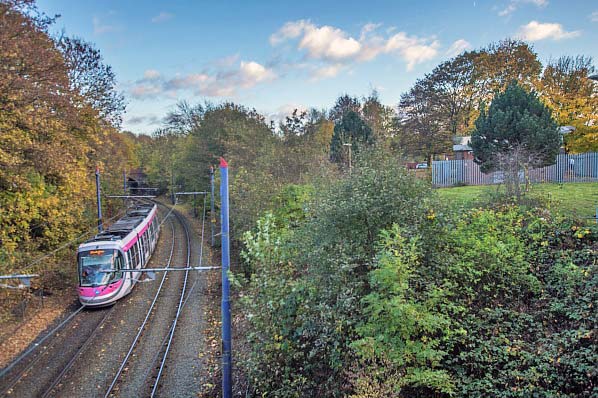 The view from the George Street overbridge on 5 November 2016 with a tram peeling off towards Birmingham on the course of the former main lines. The raised area, to the right, is the site of the former OWWR line to Dudley.
The view from the George Street overbridge on 5 November 2016 with a tram peeling off towards Birmingham on the course of the former main lines. The raised area, to the right, is the site of the former OWWR line to Dudley.